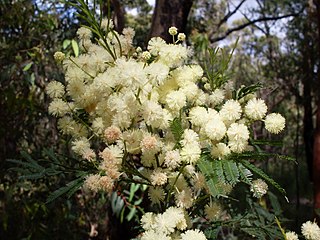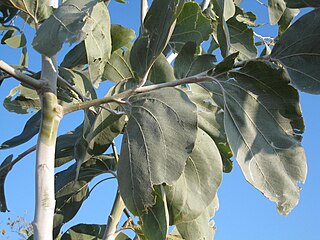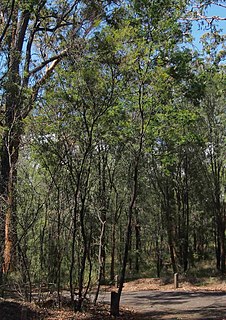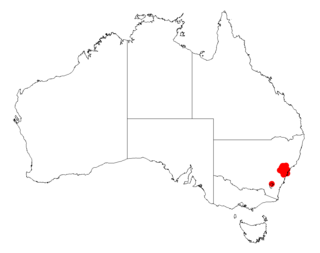
Acacia cultriformis, known as the knife-leaf wattle, dogtooth wattle, half-moon wattle or golden-glow wattle, is a perennial tree or shrub of the genus Acacia native to Australia. It is widely cultivated, and has been found to have naturalised in Asia, Africa, North America, New Zealand and South America. A. cultriformis grows to a height of about 4 m (13 ft) and has triangle-shaped phyllodes. The yellow flowers appear from August to November in its natural range. Its attractive foliage and bright flowers make it a popular garden plant.

Acacia parramattensis, commonly known as Parramatta wattle, is a tree of the family Fabaceae native to the Blue Mountains and surrounding regions of New South Wales. It is a tall shrub or tree to about 15 m (50 ft) in height with finely divided bipinnate leaves and yellow flowers that appear over summer. It generally grows in woodland or dry sclerophyll forest on alluvial or shale-based soils, generally with some clay content.

Acacia decurrens, commonly known as black wattle or early green wattle, is a perennial tree or shrub native to eastern New South Wales, including Sydney, the Greater Blue Mountains Area, the Hunter Region, and south west to the Australian Capital Territory. It grows to a height of 2–15 m (7–50 ft) and it flowers from July to September.

Acacia deanei is a tree native to Australia, which is useful for controlling soil erosion. There are two subspecies: Acacia deanei subsp. deanei and Acacia deanei subsp. paucijuga.

Acacia blayana, commonly known as Blay's wattle or Brogo wattle, is a tree of the genus Acacia that is native to south eastern Australia.

Acacia pubescens, also known as the downy wattle, is a species of wattle found in the Sydney Basin in eastern New South Wales. The downy wattle is classified as vulnerable; much of its habitat has vanished with the growth of the city of Sydney.

Acacia caesiella, commonly known as tableland wattle, bluebush wattle or blue bush, is a shrub or small tree that is endemic to eastern Australia.

Acacia gonoclada, also known as ganambureng, is a tree or shrub belonging to the genus Acacia and the subgenus Juliflorae that is endemic to northern Australia.

Acacia kelleri is a shrub or tree belonging to the genus Acacia and the subgenus Juliflorae that is endemic to north western Australia.

Acacia stipuligera is a tree or shrub belonging to the genus Acacia and the subgenus Juliflorae. It is native to arid and tropical parts of northern Australia.

Acacia wanyu, commonly known as wanyu or silver-leaf mulga, is a shrub or tree belonging to the genus Acacia and the subgenus Juliflorae that is endemic to arid parts of western Australia. The Kurrama people know it as Murruturu or Yirritiri while the Nyangumarta people know it as Wayartany.

Acacia dunnii, commonly known as elephant ear wattle or Dunn's wattle, is a shrub or tree of the genus Acacia and the subgenus Plurinerves.

Acacia trineura, known colloquially as three-nerve wattle or three nerved wattle or green wattle, is a species of Acacia native to south eastern Australia.

Acacia chinchillensis, commonly known as the chinchilla wattle, is a species of Acacia native to eastern Australia.

Acacia constablei, commonly known as the Narrabarba wattle, is a species of Acacia native to eastern Australia, and is listed as a vulnerable species.

Acacia storyi, commonly known as Story's wattle, is a species of Acacia of the subgenus Botrycephalae that is native to eastern Australia. It is listed as near threatened according to the Nature Conservation Act 1992 of Queensland.

Acacia arafurica is a shrub belonging to the subgenus Phyllodineae of the genus Acacia in the family Fabaceae. It is endemic to the Northern Territory, Australia.

Acacia abbreviata is a shrub belonging to the genus Acacia and the subgenus Juliflorae. It is endemic to arid parts of northern Australia

Acacia saliciformis is a shrub or tree belonging to the genus Acacia and the subgenus Phyllodineae native to eastern Australia.
Acacia tessellata is a shrub or tree of the genus Acacia and the subgenus Plurinerves that is endemic to a small area of eastern Australia.




















